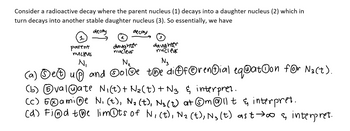Question
thumb_up100%

Transcribed Image Text:Consider a radioactive decay where the parent nucleus (1) decays into a daughter nucleus (2) which in
turn decays into another stable daughter nucleus (3). So essentially, we have
decay
decay
1
parent
nucleus
daughter
nucleus
daughter
nucleus
N₁
№₂
N3
(a) Oet up and solve the dif@rential eq@aton for N3(t).
(b) val@ate N₁(t) + N₂(t) + N3 & interpret.
(c) Gamie N₁ (t), N₂ (t), N3 (7) at ©m@llt & interpret.
(d) Find the limits of N₁ (t), N₂ (t), N₂ (t) ast →∞0 & interpret.
3
Expert Solution
This question has been solved!
Explore an expertly crafted, step-by-step solution for a thorough understanding of key concepts.
Step by stepSolved in 6 steps with 6 images

Knowledge Booster
Similar questions
- A piece of charcoal used for cooking is found at the remains of an ancient campsite. A 1.19 kg sample of carbon from the wood has an activity of 2340 decays per minute. Find the age of the charcoal. Living mate- rial has an activity of 15 decays/minute per gram of carbon present and the half-life of 14C is 5730 y. Answer in units of y. I got 7300.99 but that wasn’t right Can you please help!arrow_forwardAs a staff scientist at a nuclear power plant, it is your job to understand radioactive substances used by your co-workers. In a particular radioactive sample, you found that the number of nuclei decreased to one-sixth the original number of nuclei over an 18 d period. Determine the half-life of the sample (in days).arrow_forwardα decay producing 228R . The parent nuclide is nearly 100% of the natural element and is found in gas lantern mantles and in metal alloys used in jets (228Ra is also radioactive).arrow_forward
- Two radioactive isotopes, X and Y, both decay to stable products. The half-life of X is about aday, while that of Y is about a week. Suppose a radioactive sample consists of a mixture of thesetwo nuclides. If the mixture is such that the activities arising from X and Y are initially equal,then a few days later the activity of the sample will be due ………………………………… .i. predominantly to X.ii. predominantly to Y.iii. to X and Y equally.iv. entirely to Y.arrow_forwardA sample of radioactive isotope is found to have an activity of 110 Bq imediately after it is pulled from the reactor that formed the isotope. Its activity 1 h, 20 min later is measured to be 89 Bq. Find the decay constant of the sample. Answer in units of h-. Find the half-life of the sample. Answer in units of h. How many radioactive nuclei were there in the sample initially?arrow_forwardConsider the fission reaction see image After having found the missing nuclide, calculate the Q-value of the reaction. Enter your result in MeV to 1 decimal placearrow_forward
- Thorium 22890Th produces a daughter nucleus that is radioactive. The daughter, in turn, produces its own radioactive daughter, and so on. This process continues until bismuth 21883Bi is reached. What are (a) the total number Nα of α particles and (b) the total number Nβ of β- particles that are generated in this series of radioactive decays?arrow_forwardThere is more than one isotope of natural uranium. If a researcher isolates 0.7 mg of the relatively scarce 235U and finds this mass to have an activity of 78.0 Bq, what is its half-life in years? =___yearsarrow_forward
arrow_back_ios
arrow_forward_ios